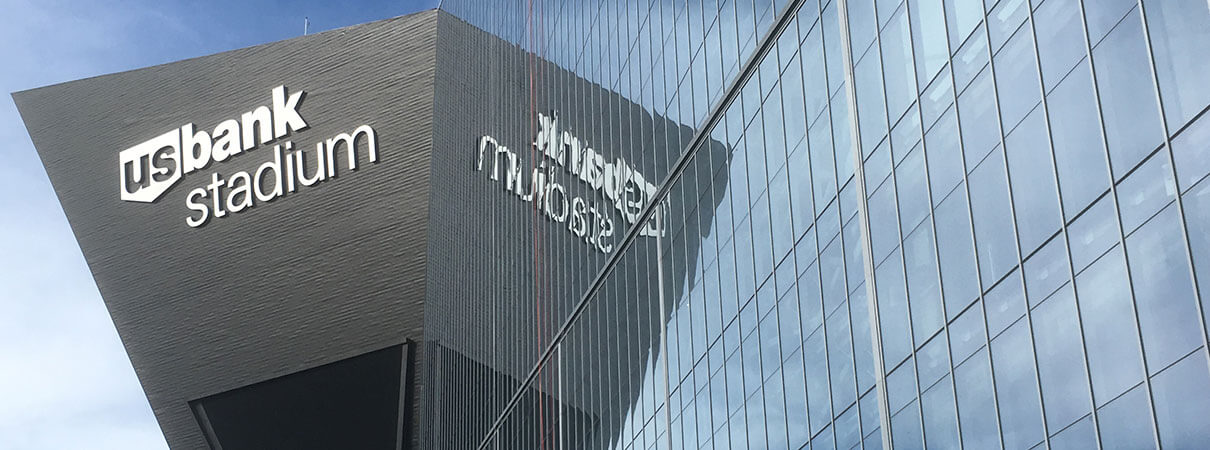Minnesota Vikings' Stadium is Bad for Birds, but It's Not Too Late for a Solution
Each year in the United States, window collisions kill up to 1 billion birds. While this is a massive source of human-caused bird mortality, trailing only free-roaming cats and habitat loss, there is good news: Window collisions are preventable!
The bad news: Most new buildings do not incorporate bird safety into their design, and scores of existing buildings (including homes) need to have their deadliest windows treated to prevent collisions.
A new study, led by collisions expert Scott Loss of Oklahoma State University, examined what happens when developers choose not to design a bird-friendly building. The research focused on the Minnesota Vikings' US Bank Stadium, which was completed in 2016 and features a large amount of glass. It also included another 20 area buildings for comparison. These buildings were selected to include structures with known low, medium, and high bird collision rates.

US Bank Stadium. Photo by Gian Lorenzo Ferretti/Shutterstock
Loss's team found that US Bank Stadium kills at least 111 birds each year, including Ruby-throated Hummingbird, American Redstart, and Wood Thrush. This may not seem like a lot of birds, but imagine a pile of 111 birds at your feet, or think of the running total in the future: 2,775 birds in 25 years; 5,550 birds in 50 years. These numbers also do not include the birds that hit the glass and are able to fly away, many of which die elsewhere or are significantly impaired for the rest of their lives. This is a lot of birds.
It is also a number that might be expected to grow over time if nothing is done.
The amount of glass and the amount of surrounding vegetation were found to be leading factors predicting collision rates in this study. While it seems unlikely that more glass will be added to the stadium, the threat posed by the surrounding vegetation is almost certain to grow in the future. The trees planted during construction are currently small. However, they will mature and become a stronger magnet for birds, drawing even more individuals into close proximity with the stadium's deadly windows than they currently do.

Glass reflection at US Bank Stadium. Photo by Jim Teter
Loss's team identified other deadly buildings, two of which kill even more birds than the stadium. All of these buildings, as well as buildings of all types across the county, must be part of the solution if we want to save hundreds of millions of birds. This brings us to the actions that should be taken.
Step 1: Make US Bank Stadium Safer for Birds
We hope that the Minnesota Sports Facilities Authority, along with the owners of the other problem buildings identified, will take corrective action to remediate their windows. The primary step should be the addition of bird-deterrent patterns to the glass through window films, etching, or window replacement. American Bird Conservancy is here to help find the best solutions.
Light pollution should also be reduced overnight during spring and fall migration, with lights turned off from midnight until the following evening. (Please note: Turning out the lights is not a substitute for fixing the windows – the glass is the primary concern.)
Step 2: Enact Bird-friendly Building Legislation
There are simply too many new buildings going up for conservationists to be able to approach each developer for individual conversations and improvements. Instead, we need a policy-driven approach with the federal government, states, and municipalities adopting bird-friendly building design ordinances and rules.
When incorporated from the beginning, bird-friendly design does not add significantly to project costs – and it results in beautiful buildings.
Please let your elected officials know that you would like to see action on bird-friendly buildings. If they do not know that their constituents are concerned about this issue, they will not act. It is up to those who value the lives of birds to make their voices heard. Start here by sending a letter supporting the Bird-Safe Buildings Act.
Step 3: Fix the Windows where You Live & Work – They Are Part of the Problem
If you're reading this, you can help save birds from collisions too! We cannot focus only on the buildings that kill hundreds of birds. Many buildings in the U.S., probably including your own home, kill a handful of birds each year. With a population of 325 million people, these one- to three-story buildings add up to kill 42 percent of the total U.S. annual bird collision mortality of up to 1 billion victims.
It isn't hard to make your home safer for birds. Start by applying inexpensive, appealing retrofits to every home and office window that you already know is a bird hazard. Then, each time you hear a new collision, treat that window. Soon you will have addressed a handful of windows and stopped almost the entire collision problem where you live.
Ready to learn more? Visit www.birdsmartglass.org for a list of proven solutions to window collisions.
 Dr. Bryan Lenz is ABC's Bird Collisions Campaign Manager. He earned his Ph.D. at Tulane University and worked as the Director of the Community Conservation program at Bird City Wisconsin, and as the Chief Scientist at the Western Great Lakes Bird & Bat Observatory. At ABC, Bryan works to reduce the collision threat that the built environment, especially glass, poses to birds. His work incorporates research, design, legislation, building codes, education, outreach, and marketing.
Dr. Bryan Lenz is ABC's Bird Collisions Campaign Manager. He earned his Ph.D. at Tulane University and worked as the Director of the Community Conservation program at Bird City Wisconsin, and as the Chief Scientist at the Western Great Lakes Bird & Bat Observatory. At ABC, Bryan works to reduce the collision threat that the built environment, especially glass, poses to birds. His work incorporates research, design, legislation, building codes, education, outreach, and marketing.


















































